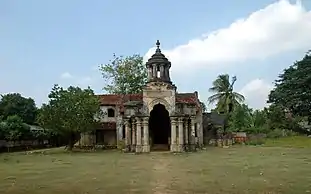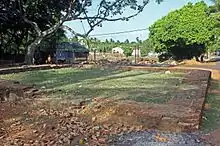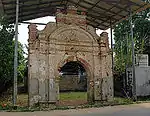Ruins of Jaffna kingdom
Ruins of Jaffna kingdom refer to the remains of the Remaining building structures of Jaffna kingdom, the royal abode and structure of the ruling dynasty of the Kingdom of Jaffna, Nallur, Jaffna in Northern Sri Lanka.

History and Inception
The palace was the home to the Aryacakravarti dynasty which became a powerful force in the North, North-East and the West of the islands prior to the conquest of the Portuguese into the island.[1]
According to Ibn Batuta, a renowned Moroccan historian, the kingdom had two capitals;Nallur was one and the other being Puttalam presently in the Western Province.[2][3]
Architecture

The construction of the Royal Palace has been ordered by Cinkai Ariyan Cekaracacekaran. But, another source says the palace and a flower garden was built by a Tamil king named Koolanghai in 104 AD.[4]
There were two main roadways and four temples at the four gateways that have now been destroyed. The rebuilt temples that exist now do not match their original locations which instead are occupied by churches erected by the Portuguese. The center of the city was Muthirai Santhai (market place) and was surrounded by a square fortification around it. There were courtly buildings for the Kings, Brahmin priests, soldiers and other service providers in the palace premises. The old Nallur Kandaswamy temple functioned as a defensive fort with high walls. In general, the palace and the city was laid out like the traditional temple towns in South India.[4][5]
Destruction
The Jaffna Palace was significantly damaged during the Portuguese conquest of the Jaffna Kingdom. The fall of Cankili II, the last of the ruling dynasty at the hands of a 5000 men-strong Portuguese invaders inevitably meant the fall of the Jaffna Throne.[6]
Over the next 40 years, the Portuguese destroyed Hindu temples in the region, the royal repository of all literary output of the kingdom. Yamuna Eri, Cankili Thoppu archway, Ruins of foundation of the Cankilian Thoppu and Mantri Manai are few of the only remaining parts of the palace apart from several small monuments that dot the compound.[7][8]
Gallery

 Cankili Thopu, Facade of the palace
Cankili Thopu, Facade of the palace.JPG.webp) Wood carving at Mantri Manai
Wood carving at Mantri Manai.JPG.webp) Front top
Front top.JPG.webp) Rear side
Rear side.JPG.webp) Indoor, silhouette of the entrance
Indoor, silhouette of the entrance.JPG.webp) Inside, rear entrance and well
Inside, rear entrance and well
References
- Abeysinghe, T Jaffna Under the Portuguese, p.4
- Gunasingam, M Sri Lankan Tamil Nationalism, p.54
- Codrington, Humphry William. "Short history of Sri Lanka:Dambadeniya and Gampola Kings (1215–1411)". Lakdiva.org. Retrieved 2007-11-25.
- Katiresu, Subramanier (18 March 2018). A Hand Book to the Jaffna Peninsula and a Souvenir of the Opening of the Railway to the North. Asian Educational Services. ISBN 9788120618725 – via Google Books.
- "Nallur Rajadhani: City Layout". V.N.Giritharan. Archived from the original on 2007-12-25. Retrieved 2007-12-02.
- De Silva, Portuguese Encounters with Sri Lanka and the Maldives, p. 95, 110, 111 & 137
- "Places of interest in Jaffna". Urlaub-sr-lanka.info. 2013-01-19. Retrieved 2013-11-28.
- "Rise of ruins from ravages of war". Sundaytimes.lk. Retrieved 2013-11-28.
